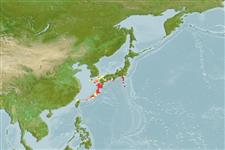Environment: milieu / climate zone / depth range / distribution range
Ecologie
marien rifbewoner. Subtropical; 35°N - 25°N
Northwest Pacific: Wakayama Prefecture south to the Ryukyu Islands.
Grootte / Gewicht / Leeftijd
Maturity: Lm ? range ? - ? cm
Max length : 5.0 cm SL mannelijk / geslacht onbekend; (Ref. 559)
Dorsale stekels (totaal): 12; Dorsale zachte stralen (totaal): 19-20; Anale stekels 2; Anale zachte stralen: 17 - 18. Nasal and supraorbital cirri slender and pointed, nuchal cirrus shot and simple. Both sexes with low occipital crest. Breast and anterior part of dorsal fin with characteristic markings; breast with brownish-yellow spot; anterior dorsal fin with red spot. Anterior anal rays in males somewhat elongate. Attains 5 cm SL.
Facultative air-breathing (Ref. 126274); Adults occur in coral reefs (Ref. 559); common in the intertidal zone (Ref. 637). Oviparous. Eggs are demersal and adhesive (Ref. 205), and are attached to the substrate via a filamentous, adhesive pad or pedestal (Ref. 94114). Larvae are planktonic, often found in shallow, coastal waters (Ref. 94114).
Levenscyclus en paargedrag
Maturiteit | Voortplanting | Paaien | Eieren | Fecunditeit | Larven
Oviparous, distinct pairing (Ref. 205).
Masuda, H., K. Amaoka, C. Araga, T. Uyeno and T. Yoshino, 1984. The fishes of the Japanese Archipelago. Vol. 1. Tokai University Press, Tokyo, Japan. 437 p. (text). (Ref. 559)
Status op de Rode Lijst van het IUCN (Ref. 130435)
Gevaar voor de mens
Harmless
Gebruik door de mens
Meer informatie
ReferentiesAquacultuurAquacultuurprofielKweeklijnenGeneticaElectrophoresesErfelijkheidZiektesVerwerkingNutrientsMassaconversie
Tools
Speciale rapporten
Download XML
Internetbronnen
Estimates based on models
Preferred temperature (Ref.
123201): 23.3 - 25.6, mean 24.7 °C (based on 50 cells).
Fylogenetische diversiteitsindex (Ref.
82804): PD
50 = 0.5001 [Uniqueness, from 0.5 = low to 2.0 = high].
Bayesian length-weight: a=0.01072 (0.00480 - 0.02393), b=3.01 (2.82 - 3.20), in cm total length, based on LWR estimates for this (Sub)family-body shape (Ref.
93245).
Trofisch niveau (Ref.
69278): 2.1 ±0.2 se; based on diet studies.
Weerstandsvermogen (Ref.
120179): Hoog, minimale populatieverdubbelingstijd minder dan 15 maanden (Preliminary K or Fecundity.).
Fishing Vulnerability (Ref.
59153): Low vulnerability (10 of 100).
